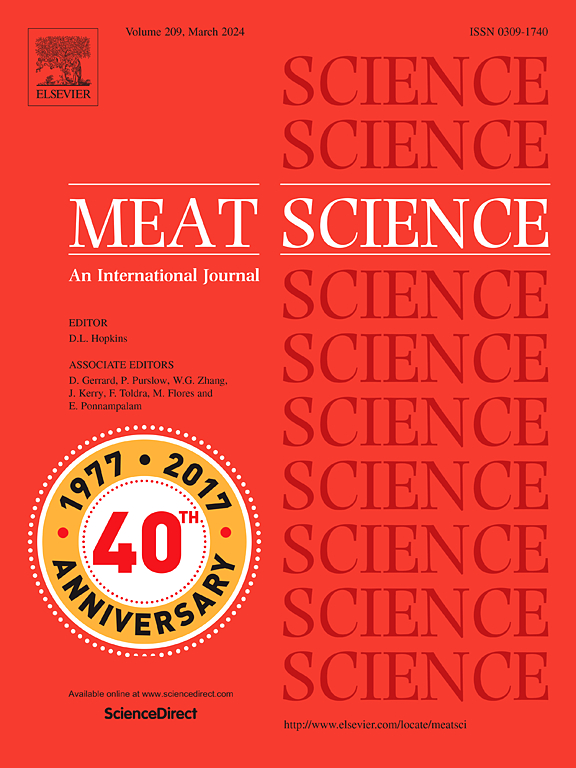伊比利亚干腌火腿的代谢组学分析:区分不同商业类别火腿的初步方法
IF 6.1
1区 农林科学
Q1 Agricultural and Biological Sciences
引用次数: 0
摘要
25年来,大量的研究旨在区分由不同遗传(纯伊比利亚与杂交)和饲养背景(自然资源与商业饲料)的猪生产的伊比利亚干腌火腿。某些先进的基于质谱的分析工具已被发现对各种肉类产品的特征和认证很有用。在这里,首次使用Q-Exactive Orbitrap质谱(MS)设备分析了伊比利亚干腌火腿的代谢组(超过3000种已确定的化合物),它们来自三个最有价值的类别,分别被标记为黑色、红色和绿色。本文报道了伊比利亚干腌火腿中35种最丰富的化学物质的化学结构、可能的来源和作用。此外,伊比利亚火腿的遗传背景不同,即黑色火腿(100%伊比利亚火腿)和红色火腿(50%伊比利亚火腿)在142种鉴别代谢物上存在差异。在以自然资源饲养的猪生产的RED火腿中发现了66种不同的代谢物,而在以精料饲养的猪生产的GREEN火腿中发现了70种不同的代谢物。该方法为伊比利亚干腌火腿提供了初步的代谢指纹图谱,为鉴定提供了依据。本文章由计算机程序翻译,如有差异,请以英文原文为准。
Metabolomic profiling of Iberian dry-cured ham: Preliminary approach to discriminate between hams from different commercial categories
For more than 25 years, profuse research has aimed to discriminate Iberian-dry-cured hams produced from pigs differing in genetics (pure Iberian vs. crosses) and feeding background (natural resources vs. commercial feeds). Certain advanced MS-based analytical tools have been found useful to characterise and authenticate a variety of meat products. Here, for the first time, the metabolome (more than 3000 identified compounds) of Iberian dry-cured hams from the three most valuable categories, labeled as BLACK, RED and GREEN, is analysed using a Q-Exactive Orbitrap mass-spectrometry (MS) equipment. The chemical structure, plausible origin and role played by the 35 most abundant chemical species in Iberian dry-cured hams, are reported. Additionally, Iberian hams differing in genetic background namely, BLACK (100 % Iberian) and RED (50 % Iberian) were found to differ in 142 discriminating metabolites. Sixty-six distinctive metabolites were found in RED hams, produced from pigs fed on natural resources, while seventy discriminating metabolites were identified in GREEN hams, produced from pigs fed on concentrate. The method applied provided a preliminary metabolic fingerprinting of Iberian dry-cured hams, which may be helpful for authentication purposes.
求助全文
通过发布文献求助,成功后即可免费获取论文全文。
去求助
来源期刊

Meat Science
工程技术-食品科技
CiteScore
12.60
自引率
9.90%
发文量
282
审稿时长
60 days
期刊介绍:
The aim of Meat Science is to serve as a suitable platform for the dissemination of interdisciplinary and international knowledge on all factors influencing the properties of meat. While the journal primarily focuses on the flesh of mammals, contributions related to poultry will be considered if they enhance the overall understanding of the relationship between muscle nature and meat quality post mortem. Additionally, papers on large birds (e.g., emus, ostriches) as well as wild-captured mammals and crocodiles will be welcomed.
 求助内容:
求助内容: 应助结果提醒方式:
应助结果提醒方式:


